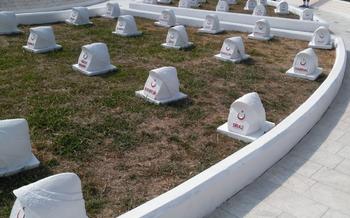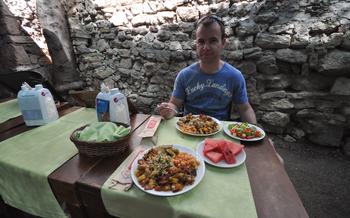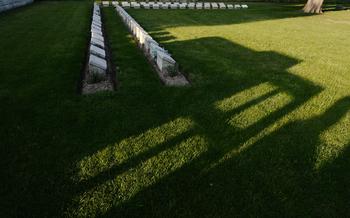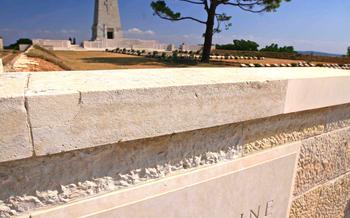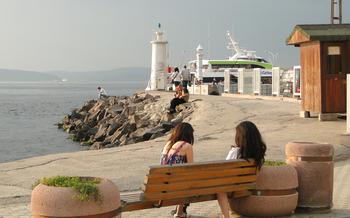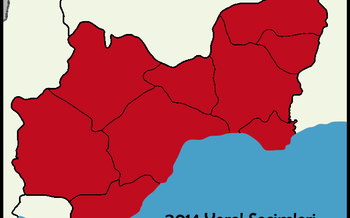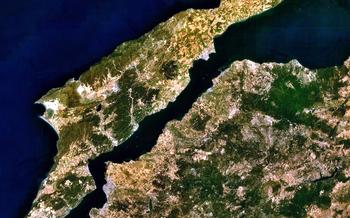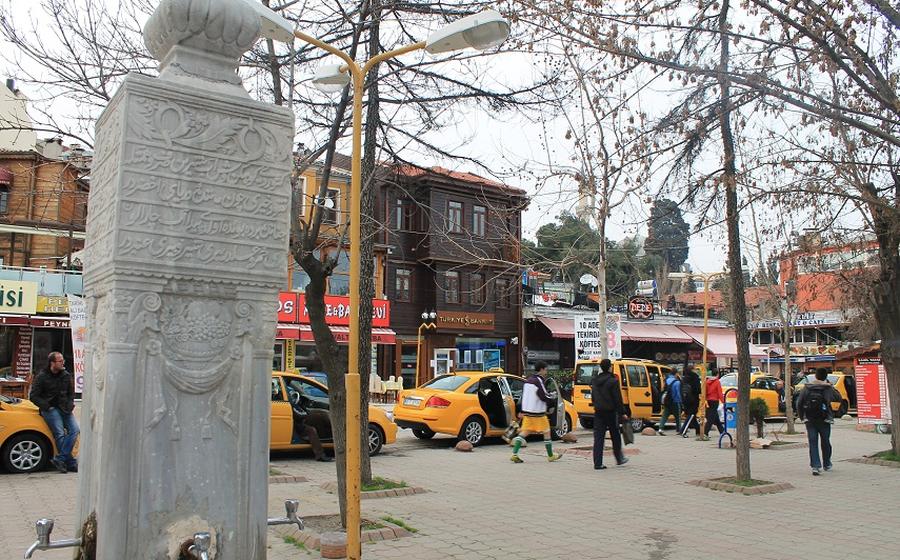
Gallipoli Peninsula Historical Site
- Gallipoli Peninsula: A Crossroads of Civilizations and War
- Remembering the ANZACs: The Cove and the Landing Beaches
- Exploring Lone Pine: A Symbol of Courage and Sacrifice
- Paying Respects at the Çanakkale Martyrs' Memorial
- Walking the Nek: A Poignant Journey Through History
- Visiting the Turkish 57th Regiment Memorial: Honoring Resilience
- Exploring Chunuk Bair: A Strategic Battlefield
- Discovering the Quinn's Post Trench System: A Labyrinth of History
- A Walk Through History: The Gallipoli Peninsula Walk Trail
- Practical Information for Hikers
- Visiting the Gallipoli Museum: Unveiling the Past
- Attending the Dawn Service: A Moving Tribute
- Exploring the Surrounding Area: Beyond the Battlefields
- Respecting the Sacred Ground: Etiquette and Behavior
- Planning Your Visit: Essential Tips and Information
- Insider Tip: Unveiling a Hidden Gem - The ANZAC Commemorative Site
Gallipoli Peninsula: A Crossroads of Civilizations and War
The Gallipoli Peninsula, a slender stretch of land jutting out into the Aegean Sea, holds a profound significance in the annals of history. Throughout the centuries, it served as a pivotal crossroads for diverse civilizations, from the ancient Greeks and Romans to the Byzantine and Ottoman empires. Its strategic location at the crossroads of Europe and Asia rendered it a coveted gateway, leading to numerous conflicts and power struggles over the ages.
In the First World War, the Gallipoli Campaign, launched by the Allied forces in 1915, transformed the peninsula into a battleground of immense proportions. The ill-fated campaign, intended to secure control of the Dardanelles Strait and ultimately knock the Ottoman Empire out of the war, resulted in a devastating stalemate and heavy casualties on both sides. The Gallipoli Peninsula, forever etched with the scars of war, now stands as a poignant historical site, a solemn testament to the human cost of conflict.
Remembering the ANZACs: The Cove and the Landing Beaches
The Gallipoli Peninsula is forever etched in the annals of history as the site of the ill-fated Gallipoli Campaign during World War I. At the heart of this historic struggle lies ANZAC Cove, the landing site of the Australian and New Zealand Army Corps (ANZACs). Today, visitors can retrace the footsteps of these brave soldiers and pay homage to their sacrifice.
The significance of ANZAC Cove
ANZAC Cove holds immense significance as the landing point for the ANZAC forces on April 25, 19The cove's rugged terrain and steep cliffs posed formidable challenges for the troops, who faced a barrage of gunfire as they struggled to establish a foothold. The cove remains a hallowed ground, symbolizing the courage and determination of the ANZACs.
The landing beaches of the Gallipoli Campaign
The Gallipoli Peninsula is dotted with several landing beaches, each bearing witness to the ferocity of the campaign. Visitors can explore these beaches, including ANZAC Cove, Brighton Beach, and Suvla Bay, to gain a deeper understanding of the challenges faced by the Allied forces. The beaches serve as poignant reminders of the sacrifices made during this pivotal battle.
Commemoration of the ANZACs and other Allied forces
The Gallipoli Peninsula is a place of remembrance and commemoration, honoring the fallen soldiers from both sides of the conflict. Memorials and monuments dot the landscape, paying tribute to the bravery and sacrifice of the ANZACs and other Allied forces. Visitors can pay their respects at these memorials, reflecting on the profound impact of the Gallipoli Campaign.
Exploring Lone Pine: A Symbol of Courage and Sacrifice
Lone Pine stands as a poignant reminder of the fierce battle that took place in August 1915, where Australian and Turkish soldiers fought with unwavering bravery and indomitable spirit. Delving into the Lone Pine trenches, visitors can almost feel the echoes of the intense combat that unfolded here. The labyrinth of trenches, dugouts, and tunnels offers a palpable sense of the challenging conditions and harsh realities faced by the soldiers on both sides.
At the heart of Lone Pine lies the Lone Pine Memorial, a serene and moving tribute to the fallen soldiers of both nations. The memorial, designed by the renowned Australian architect John Treloar, features a simple yet powerful obelisk surrounded by commemorative plaques bearing the names of over 4,000 Australian and 2,000 Turkish soldiers who perished in the battle. The silence that envelops Lone Pine is punctuated only by the gentle rustling of the surrounding pine trees, inviting visitors to reflect on the immense sacrifice and camaraderie exhibited by the soldiers who fought here.
Lone Pine transcends its role as a historical site; it has become a symbol of courage, resilience, and the futility of war. It stands as a testament to the shared suffering and sacrifice of the ANZACs and the Turkish soldiers, fostering a spirit of reconciliation and understanding between the two nations. Visitors to Lone Pine are profoundly moved by the palpable sense of history, paying their respects to the fallen and contemplating the profound lessons of war and peace.
Paying Respects at the Çanakkale Martyrs' Memorial
The Çanakkale Martyrs' Memorial, also known as the Çanakkale Şehitleri Anıtı, is a poignant and iconic tribute to the Turkish soldiers who lost their lives during the Gallipoli Campaign. Constructed between 1954 and 1960, this awe-inspiring memorial stands as a symbol of Turkey's resilience, sacrifice, and unwavering spirit.
Designed by renowned Turkish architect Emin Halid Onat, the memorial is a masterpiece of architectural significance. Its striking design features a series of cascading terraces that symbolize the waves of soldiers who fought valiantly against overwhelming odds. The memorial's centerpiece is a majestic tower that rises 41 meters into the sky, representing the eternal flame of remembrance that burns brightly in the hearts of the Turkish people.
At the base of the memorial, visitors are greeted by a serene reflecting pool that mirrors the surrounding landscape. The tranquil waters create a contemplative atmosphere, inviting visitors to pause and reflect on the immense sacrifice made by the Turkish soldiers. As they ascend the terraces, visitors encounter a series of bronze sculptures that depict scenes of bravery, camaraderie, and the indomitable spirit of the Turkish army.
The eternal flame, a symbol of perpetual remembrance, flickers atop the memorial's tower, casting a warm glow over the surrounding landscape. This eternal flame is a powerful reminder of the enduring legacy of the Turkish soldiers who fought and died in the defense of their homeland.
The Çanakkale Martyrs' Memorial is not just a monument to the past; it is also a place of remembrance and reconciliation. It serves as a poignant reminder of the tragic consequences of war and the importance of fostering peace and understanding among nations. Visitors from all over the world come to pay their respects to the fallen soldiers and to learn about the significant role that Turkey played in the Gallipoli Campaign.
Walking the Nek: A Poignant Journey Through History
The Nek battlefield stands as a poignant reminder of the tragic events that unfolded during the Gallipoli Campaign. This small, exposed ridge became the scene of one of the most ill-fated attacks in the entire campaign. On August 7, 1915, the Australian and New Zealand troops launched a frontal assault on the Nek, hoping to break through the Turkish lines. However, they were met with a barrage of machine gun fire and artillery shells, resulting in devastating casualties.
The Nek battlefield is a somber and moving place, where visitors can pay their respects to the fallen soldiers. The terrain is scarred with trenches, shell craters, and remnants of barbed wire, providing a tangible connection to the horrors of war. Walking through the battlefield, one can almost sense the desperation and courage of the young men who fought and died here.
The Turkish defenders also suffered heavy losses during the battle, and their stories are equally poignant. They fought bravely to defend their homeland, and many lost their lives in the process. The Nek battlefield is a place where both sides experienced immense suffering, and it serves as a reminder of the futility of war.
Today, the Nek battlefield is a place of commemoration and remembrance. Visitors can walk through the trenches, explore the memorials, and reflect on the sacrifice of the soldiers who fought here. It is a place to learn about the horrors of war and to honor the memory of those who lost their lives.
Visiting the Turkish 57th Regiment Memorial: Honoring Resilience
Amidst the poignant memorials and battlefields of the Gallipoli Peninsula, the Turkish 57th Regiment Memorial stands as a testament to the bravery and resilience of the Turkish soldiers who fought valiantly against the Allied forces during the Gallipoli Campaign. Constructed in 1992, the memorial pays homage to the heroic defense of the 57th Regiment, which played a crucial role in repelling the Allied attacks.
The memorial features a striking monument depicting a Turkish soldier standing defiantly, symbolizing the unwavering spirit of the regiment. Surrounding the monument are the names of the fallen soldiers, etched in stone as a tribute to their ultimate sacrifice. Visitors can wander through the memorial grounds, immersing themselves in the stories of courage and sacrifice that unfolded on this historic battlefield.
The Turkish 57th Regiment Memorial serves as a reminder of the immense human cost of war and the enduring legacy of the Gallipoli Campaign. It is a place for reflection and remembrance, honoring the bravery of the Turkish soldiers who fought to defend their homeland.
Exploring Chunuk Bair: A Strategic Battlefield
Chunuk Bair, a hilltop strategically positioned on the Gallipoli Peninsula, played a pivotal role in the campaign. Its elevation offered a commanding view of the surrounding terrain, making it a crucial objective for both the Allied and Turkish forces. The fierce fighting over Chunuk Bair resulted in heavy casualties on both sides, as each side recognized its significance.
The New Zealand Memorial, situated atop Chunuk Bair, stands as a poignant reminder of the sacrifices made by the New Zealand troops during the battle. The memorial's design incorporates elements of both Turkish and New Zealand culture, symbolizing the shared history and respect between the two nations.
Today, Chunuk Bair remains a significant battlefield, drawing visitors who seek to understand the complexities of the Gallipoli campaign. Its strategic importance, coupled with the stories of bravery and sacrifice that unfolded on its slopes, makes it a compelling destination for those interested in military history and the human toll of war.
Discovering the Quinn's Post Trench System: A Labyrinth of History
The Quinn's Post trench system stands as a testament to the ingenuity and resilience of the soldiers who fought in the Gallipoli campaign. Constructed by the Australian and New Zealand forces, these intricate trenches served as a defensive stronghold against the Turkish advance. The system comprised a network of interconnected trenches, dugouts, and tunnels, allowing troops to move and communicate effectively.
The significance of the Quinn's Post trenches lies in their strategic position. Located on a hilltop overlooking the Dardanelles Strait, the trenches provided a vantage point for artillery and observation. The labyrinthine layout, with its multiple firing positions and concealed routes, made it a formidable defensive position. The trenches played a crucial role in the Battle of Quinn's Post, a fierce engagement that resulted in heavy casualties on both sides.
Today, the Quinn's Post trench system has been meticulously preserved as a historical site. Visitors can explore the trenches, marveling at the engineering feats and imagining the harrowing conditions the soldiers endured. The trenches serve as a poignant reminder of the human cost of war and the courage and sacrifice displayed by the soldiers who fought here.
A Walk Through History: The Gallipoli Peninsula Walk Trail
The Gallipoli Peninsula Walk Trail is a unique and immersive experience that allows visitors to explore the battlefields of the Gallipoli campaign on foot. The trail covers a distance of approximately 10 kilometers and takes hikers through some of the most significant sites of the campaign.
Along the trail, hikers can explore the ANZAC Cove, where the Australian and New Zealand troops landed on April 25, 19They can also visit the Lone Pine trenches, where some of the fiercest fighting of the campaign took place. The trail also passes by the Çanakkale Martyrs' Memorial, which commemorates the Turkish soldiers who died in the campaign.
The Gallipoli Peninsula Walk Trail is a challenging but rewarding experience that provides hikers with a unique perspective on the Gallipoli campaign. It is a great way to learn about the history of the campaign and to pay respects to the fallen soldiers.
Practical Information for Hikers
- Distance: Approximately 10 kilometers
- Duration: Allow for a full day to complete the trail
- Difficulty: Moderate to challenging
- Terrain: Uneven terrain, including steep hills and rocky paths
- What to Bring: Comfortable hiking shoes, water, snacks, sunscreen, and a hat
- Guided Tours: Guided tours of the Gallipoli Peninsula Walk Trail are available.
Visiting the Gallipoli Museum: Unveiling the Past
The Gallipoli Museum, situated in the heart of the Gallipoli Peninsula, serves as a poignant reminder of the sacrifices and bravery exhibited during the Gallipoli Campaign. Through its comprehensive exhibits and interactive displays, the museum provides visitors with an immersive journey into the events that unfolded on these hallowed grounds.
Exhibits at the museum showcase artifacts, photographs, and personal accounts from soldiers on both sides of the conflict. Visitors can delve into the intricate details of the campaign, gaining insights into the strategies, battles, and the immense human toll it exacted.
Multimedia presentations and interactive displays bring the past to life, allowing visitors to experience the Gallipoli Campaign from the perspectives of those who fought and perished here. The museum's aim is to foster a deeper understanding of the historical significance of Gallipoli and to honor the memory of the fallen soldiers from all nations.
Visiting the Gallipoli Museum is an essential component of any pilgrimage to the peninsula. It offers a profound and moving experience, shedding light on the complexities of the campaign and the enduring legacy it has left behind.
Attending the Dawn Service: A Moving Tribute
One of the most profound experiences at the Gallipoli Peninsula is attending the Dawn Service, held annually on April 25 to commemorate ANZAC Day. This solemn ceremony pays tribute to the Australian and New Zealand soldiers who fought and died during the Gallipoli Campaign.
The service begins before sunrise at various locations throughout the peninsula, including ANZAC Cove, Lone Pine, and Chunuk Bair. As darkness gives way to light, a hush falls over the gathering as the Last Post, a traditional bugle call, echoes through the air.
The service includes readings, prayers, and the recitation of the Ode of Remembrance, a poignant tribute to the fallen. The atmosphere is one of deep respect and remembrance as attendees pay their respects to those who sacrificed their lives in this historic battle.
The Dawn Service is a moving and powerful experience that allows visitors to connect with the history and significance of the Gallipoli Campaign. It is an opportunity to honor the memory of the ANZACs and remember their bravery and sacrifice.
Practical information for attending the Dawn Service:
- Check the official ANZAC Day website for details on service times and locations.
- Arrive early to secure a good spot and allow time for reflection.
- Dress respectfully and be prepared for cool morning temperatures.
- Maintain silence and show respect during the service.
- Photography is generally permitted, but be discreet and respectful.
Exploring the Surrounding Area: Beyond the Battlefields
The Gallipoli Peninsula offers a wealth of experiences beyond the historical sites related to the campaign. Nature enthusiasts will be captivated by the peninsula's stunning landscapes, including picturesque beaches, lush forests, and rolling hills. Visitors can embark on scenic walks, bike rides, or even horseback riding excursions to immerse themselves in the tranquil beauty of the region.
The peninsula is also home to several historical and cultural sites that shed light on its rich past. Explore ancient ruins, visit traditional villages, or marvel at the architectural wonders of mosques and churches. Each site offers a glimpse into the diverse heritage of the region, showcasing the unique blend of cultures that have shaped its identity.
For a taste of local life, venture into the charming towns and villages that dot the peninsula. Engage with the friendly locals, savor the delicious regional cuisine, and immerse yourself in the vibrant culture. From bustling markets to quaint cafes, there's something for every traveler to discover.
Don't miss the opportunity to indulge in the culinary delights of the Gallipoli Peninsula. Savor the freshest seafood, sample traditional Turkish dishes, and treat your sweet tooth to delectable desserts. Local restaurants and cafes offer a range of dining experiences, from casual eateries to fine-dining establishments, ensuring that every palate is satisfied.
Respecting the Sacred Ground: Etiquette and Behavior
Visiting the Gallipoli Peninsula is a privilege that comes with a responsibility to respect the sacred ground and pay homage to the fallen soldiers. Here are some guidelines for appropriate behavior at the historical sites:
-
Maintain Silence and Respect: Out of respect for the soldiers who fought and died here, it's essential to maintain silence and refrain from loud conversations or disruptive behavior. Allow the peaceful atmosphere of the memorials to envelop you.
-
Honor the Fallen: When visiting the cemeteries and memorials, approach with a sense of reverence and respect. Take time to read the inscriptions on the headstones and memorials, remembering the sacrifices made by so many.
-
Stay on Designated Paths: To preserve the integrity of the historical sites and protect the environment, stay on the designated paths and avoid venturing off into restricted areas.
-
Photography and Memorials: While it's understandable to want to capture the moment, be mindful when taking photographs. Avoid posing or taking selfies in front of memorials or cemeteries as a sign of respect for the fallen.
-
Dispose of Waste Responsibly: Help preserve the natural beauty of the peninsula by disposing of waste responsibly in designated bins.
-
Promote Responsible Tourism: Encourage others to follow these guidelines and promote responsible tourism practices among fellow visitors. By respecting the sacred ground, we honor the memory of those who fought and fell at Gallipoli.
Planning Your Visit: Essential Tips and Information
To make the most of your visit to the Gallipoli Peninsula, careful planning is essential. The best time to visit is during the shoulder seasons (April-May and September-October) when the weather is pleasant and the crowds are smaller. Accommodation options range from budget-friendly hostels to comfortable hotels, and transportation is readily available, with regular bus services connecting the peninsula to major cities.
For a deeper understanding of the historical sites, guided tours led by experienced historians are highly recommended. These tours provide insightful commentary and can take you to lesser-known areas of the peninsula. Alternatively, self-guided exploration allows you to set your own pace and explore at your leisure.
Pack comfortable walking shoes, as you'll be doing a lot of walking on uneven terrain. Sunscreen, insect repellent, and a hat are essential for protection against the sun and insects. Bring plenty of water, as there are limited facilities for purchasing refreshments. For safety, always stay on marked trails and be aware of the risk of unexploded ordnance.
By following these tips, you can ensure a safe and enriching visit to the Gallipoli Peninsula, where history comes alive and the sacrifices of soldiers from both sides are remembered.
Insider Tip: Unveiling a Hidden Gem - The ANZAC Commemorative Site
Beyond the well-known battlefields, the Gallipoli Peninsula holds a hidden gem that offers a unique and poignant tribute to the ANZACs. Nestled amidst the serene landscapes of the peninsula, the ANZAC Commemorative Site stands as a testament to the enduring legacy of the campaign.
Established in 1985, the site is located on a hill overlooking the Dardanelles Strait, offering breathtaking views of the surrounding area. It was conceived as a place of reflection and remembrance, a tranquil space where visitors can pay their respects to the fallen soldiers and contemplate the sacrifices made during the campaign.
The centerpiece of the site is a striking memorial, a simple yet powerful structure that evokes the spirit of camaraderie and sacrifice. The memorial features a bronze sculpture depicting two soldiers, one Australian and one New Zealander, standing side by side, their heads bowed in remembrance. The inscription on the memorial reads, "In memory of the ANZACs who fought and died at Gallipoli, 1915-191"
The atmosphere at the ANZAC Commemorative Site is one of peace and tranquility. Visitors are invited to wander through the grounds, taking time to reflect on the events that unfolded here over a century ago. The site is a place to honor the memory of the fallen, to learn about their stories, and to appreciate the significance of the Gallipoli campaign in shaping the history of both Australia and New Zealand.
For those seeking a deeper understanding of the Gallipoli campaign, the ANZAC Commemorative Site offers a unique and immersive experience. It is a hidden gem that provides visitors with a chance to connect with the past, to pay their respects, and to gain a profound appreciation for the sacrifices made by the ANZACs.
